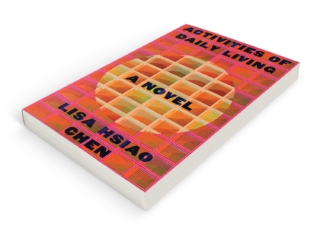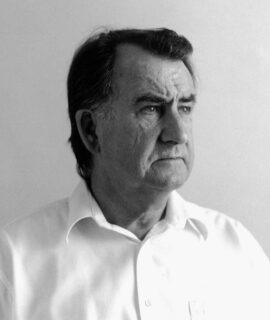
Trust
Hernan Diaz
Riverhead, $28
It’s a rare thing to fall in love at first conceit. But: a nesting doll novel that features an unreliable sequence of interconnected narrators, multiple iterations of 1930’s Swiss sanatoriums, an interpolated novella that’s also a mild pastiche of early 20th century American literature, copious research in the New York Public Library, an examination of the financial structures that undergird our world, and a recurring Bluebeard myth? It’s as if Hernan Diaz’s latest novel, Trust, was built in a lab to hit my pleasure nodes.
And yet, I can’t shake the feeling that something is missing here, like a gorgeous cut of meat that needed a touch more seasoning and a bit more sear. Perhaps when we’re excited for a book, we hold it to too high a standard. Diaz’s debut novel, In the Distance, was a wonder: a western remix with a surreal journey across America from west to east, filled with sparse reveries of open spaces. Though I quite like Trust, and recommend you read it, it’s a book whose own sparseness feels mismatched with its gilded action, and a book which may be just a touch too tidy for its own good.
To go any further necessitates breaking down the structure of the novel. Trust is told in four parts, with the majority of the action set in 1920s and 1930s New York. These parts will fractally modify and correct themselves as Trust moves from renditions of (1) fiction to (2) spurious note taking for a puff book defending the source subject of the fiction to (3) “authentic” ex post facto non-fiction about the spurious note taking for the puff book to (4) a morphine-addled diary by one of the subjects of the fiction. Benjamin Labatut’s When We Cease to Understand the World, my favorite novel of 2021, uses a similar escalating concept, but inverts it, starting with non-fiction and moving toward pure invention. There’s major pleasure here too, in this modifying form with its layers of escalating verisimilitude.
We open with Bonds, an interpolated novel by an invented character named Harold Vanner. Bonds tells the rise of Benjamin Rask, a financier who’s in a sexless marriage with Helen, a younger woman with a genius for language. The beginning is curiously hookless while Vanner fills in the detailed backstory of these lonely, desolate characters. Once they intersect, the language sparks — “In his vast solitude she would find hers, and with it, the freedom her overbearing parents always denied her” — and their wealth multiplies apace.
In their ascent, I kept thinking of Patrick Radden Keefe’s recent Empire of Pain, which tells the story of the Sackler pharmaceutical family. I was reminded of the Sacklers not just in how Rask “became fascinated by the contortions of money — how it could be made to bend back upon itself to be force-fed its own body” but by how, in a bit of what Keefe calls “reputation laundering,” “over the next several years, hospitals, concert halls, libraries, museums, shelters, and university wings appeared all over the county bearing plaques with the name of Rask on them.” The subject matter made me miss the textured detail of Empire of Pain, which thrummed with the trappings of wealth and descriptions of the era.
What, after all, makes great historical fiction? Description should double as time travel, which is somewhat missing here, but there should also be events from the world that crash in on the characters, and Diaz handles that quite well. The undertext of Trust, something that no one —until the end — fully understands, is the impact of its characters on the 1929 stock crash. In Bonds, Rask helps trigger the crash and profits from it, and Helen, in a bravura sequence, wanders around New York and is met with scorn. She is abandoned by her judgmental writer friends too, all of which exacerbates the mental illness that she has inherited from her father. Rask takes his wife to a sanitorium in Switzerland and feuds with the doctor over her care. It’s the first of a few outstanding sequences in Trust, redolent of Magic Mountain and filled with body horror that persists until Bonds whams shut.
Part Two, the most placid segment of Trust, is a long sequence of unfinished paragraphs and notes for a memoir. It’s about the “real” characters who were the source material for Bonds, appearing here for the first time: Andrew and Mildred Bevel. The outline format makes itself clear when the text suddenly breaks into a note:
“More examples of his business acumen.
Show his pioneering spirit.”
This sort of formal play is, of course, charming, but it makes one fight the urge to skim — I love blue cheese in a salad, but I don’t necessarily want to eat a brick of it — and once one knows something is an outline, it can feel less essential. Though it’s fun to puzzle out what Diaz is doing in this section, the text itself is rarely exciting, just the work of the text. These notes could have been better off threaded through part 3, which is told from the perspective of Ida Partenza, an author in her seventies who thinks back to her youth, when she was hired out of Carroll Gardens poverty (it’s the 1930’s, remember) to ghost-write Bevel’s memoir. Their first meeting in Bevel’s skyscraper is one of my favorite scenes in the novel, showing Diaz at his absolute best:
“At the other end of a colorless office that made me think of a swimming pool (and stepping into it felt like immersing myself into a different element), behind a desk, with the back of his swivel chair turned to me, sat a man looking out the window, while out there, looking back at him, was a welder sitting on a beam that seemed to be floating in the sky. A cold wave of vertigo washed over me, and I froze by the door. Each man appeared to be hypnotized by the other. But when the welder adjusted his cap and his coat, always staring at the man in the chair, I realized that, to him, the window was an impenetrable mirror”
Stunning, virtuosic stuff — wealth intersecting surreally with the expansions of the era. The plot cracks on from here as Ida’s likable charm propels the action through the interventions of her superstitious communist Italian father and tragically shitty boyfriend, and the deepening of the relationship between Ida and Bevel, which is a delight. Bevel, we learn, is furious about Bonds and his motivation in publishing his memoir is to correct the record about both his wife’s illness and his role in the Great Depression.
But the actual presence of Bonds creates a problem for Trust, because the central pretense of Trust is that Bonds was a smash. Diaz tries to pull a fast one by showing Ida reading contemporary reviews of the book — The Nation includes it in its “notable books of the year,” and The Atlantic raves over it, as it “dwells on the actual process of the accumulation of capital.” Though the New Yorker review is less positive — isn’t that the way? — I couldn’t shake the feeling that Bonds doesn’t read like a hit, because it’s a piece of something (namely: Trust) more than its own stand-alone work. Though its roots are artfully sprouted from Theodore Dreiser and Sinclair Lewis, I didn’t quite buy the rapturous reception that Diaz has concocted for his own creation. “At first Bonds was not just literature; it was evidence. And I was not just a reader; I was a detective,” writes Ida. I agree. If it had been a shadow text, like say, the novel that doesn’t exist in Dag Solstad’s Armand V, it’s greatness would be incontrovertible, but in the flesh, it makes the action seem slightly contrived.
Better is when Vanner and his work simply disappear from the archives of the New York Public Library. “There was only one explanation. Bevel, one of the library’s main donors, had bent and aligned reality.” Diaz is charmingly in love with his research in these NYPL sequences, and has his character Ida mirror it, citing the undeniable influence of “Henry James, Constance Fenimore Woolson, Amanda Gibbons and Edith Wharton,” on her work. I liked it best of all, though, when Trust was researching itself. A vignette from one character’s childhood recurs over the book in multiple sections and modifies itself until a memorable, disturbing climax when it reappears in an unlikely mouth.
Part 4 is the highlight of the novel, a masterful segment of a character’s diary with a tiny bit of magic and a twist I won’t spoil. The character’s lucidity is in flux, resulting in occasional treats of language fracture as the novel undermines a central existential concept of the plot that I had considered unimpeachable. Here too, I was happily reminded of Labatut: the action takes on a near surrealistic tenor when this character’s hidden genius is revealed. The language here is marvelous, as raw and descriptive as the other sections are polished and spare. It’s a wonderful choice by Diaz to have the mind that’s breaking down contain the secrets to the novel — it lets them remain elusive, even as the narrative fades out.
One of the most admirable traits of Trust is its novelistic ambition, which hearkens back to what was so wonderful about In the Distance. Diaz is making a career out of taking on some of the biggest archetypal American novels — the Western, and now the Wealth Novel — by simultaneously undermining and reveling in their forms. This is a fresh spin on a book that we’ve seen many times — it reminds me, in this light, of Gaddis’s JR, which is also a novel about a budding tycoon that restricts itself in charming ways. The forms of these classics are known to us, and so Diaz can rely on our knowledge to fill in the gaps. A western that flows east; a book about wealth with no definite figures.
Trust is going to be frequently compared with Susan Choi’s Trust Exercise — I’m frankly surprised that they were allowed to have such similar titles — because there is the same conceit of an initial narrative that is modified and corrected as the book proceeds away from it. Oddly, Trust simultaneously works better in its logic and less well in its action than Choi’s novel. The hunt for meaning throughout the recursion is consistently pleasurable, but the forms that Trust takes denies texture in the areas one might expect, like a painting with beautiful grass but sketched in faces.
What is odd is that Trust fully blooms when out of sight — I’ve liked it more in the writing of this review, as I’ve circled back through, relishing the characters and hijinks. All of it works, but I can’t help but think wistfully of the wide-open spaces that first made me fall in love with Diaz. Now, as he writes about an explosive time of steel, the concrete reveries that could have undergirded this beautiful edifice have gone missing. Despite this structural flaw, Diaz remains one of our most exciting authors. It’s a pleasure to have no idea what an author will take on next, to have a style that is at once so distinctive and undefined.
Adam Dalva’s writing has appeared in The New Yorker, The New York Review of Books, The Paris Review, and The Guardian. Adam serves on the board of the National Book Critics Circle and is the Books Editor for Words Without Borders. He teaches Creative Writing at Rutgers University.


